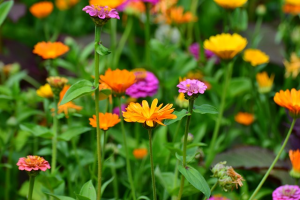The Central Florida weather is warming up quickly, but there could still be cold weather in our near future. What’s the best way to get out and exercise your gardening muscles? It’s the perfect time to start annuals from seed! Here are some tips.
With our sandy soils, a warm spring day will dry out a planting site quickly. Seeds need constant moisture, so planting in a seed tray that can be easily watered will increase your chances of success. Small pots and trays can also be brought indoors if we get a late frost, so seeds can be started now and transplanted in early March when the weather should stay warm.
Many annuals have very small seeds. That tiny capsule holds all the energy the plant will have until it can establish roots. It should be barely covered with fine potting soil, so the baby plant doesn’t run out of gas before it reaches the surface. As soon as the leaves emerge, put the tray in a spot that gets as much sun as possible.
Larger seeds such as sunflowers can be planted directly in the garden, but if your yard is home to many squirrels and birds, the seeds may become a snack before they can sprout. Starting them in small pots on a porch or other fortified location will protect the seeds from marauders. You can also try setting a rubber snake in the flower bed, but you can’t fool every bird. There’s always one that will see through your tricks!
Many spring flowers up north are cool season annuals for us, so be sure you know which ones can take the coming heat. It’s too late for classics like pansies, petunias, and snapdragons here. Check the EDIS guide to growing annuals (http://edis.ifas.ufl.edu/mg319) to see which are best suited for spring planting. There is a handy chart at the bottom that gives the best transplanting time for different varieties.
Some easy-to-grow flowers to start now from seed for transplanting in March are zinnias, torenia, salvia, marigold, gomphrena and sunflowers. Other easy and decorative plants include ornamental peppers, coleus, and flowering basils such as Siam Queen. Edibles can also be beautiful – Suyo Long cucumbers and Rattlesnake pole beans are lovely vines and will fill your table for months.
If you’d rather buy transplants once the weather warms up, look for ones that haven’t outgrown their small nursery pots. A younger healthy plant will soon outgrow a leggy root bound one. Make sure the leaves aren’t turning yellow or wilting and examine the undersides for pests. Check to see if there are multiple plants in the pot – rather than giving you a “bonus”, extra seedlings in a small pot will be too crowded to get enough nutrients and will result in stunted growth. Look for one strong stem. It’s nice to have an open flower to see the color, but plants that are covered in blooms while still in a small pot may not have energy left to grow. Young unopened buds will give a good display soon after planting instead of wasting their beauty on the garden center shelves.
This is the ideal time to start your spring garden. What a great excuse to get out and enjoy the beautiful weather!
This blog post was written by UF IFAS Extension Orange County Master Gardener, Mary Ann Pigora, class of 2017. The UF IFAS Extension Orange County Master Gardener Volunteers play a crucial role in the outreach of UF IFAS Extension.
 0
0

